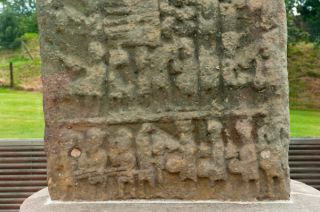
Sueno's Stone is the tallest sculptured monument in Britain. Knowing that doesn't really prepare you for your first view of the stone; it is an incredible sight, though rather incongruously set within a tall glass case.
Though the case certainly helps preserve the stone from the effects of weathering, it does rather make it more difficult to see the carving details. That said, however, Sueno's Stone is incredibly impressive; the detail of the carving is marvellous. It is no wonder that Historic Scotland calls it 'one of the most richly carved examples of Pictish art in Scotland.'
The main face of the stone is carved with a ring-headed cross, surrounded by interlaced designs. Beneath the cross is a scene with two figures leaning over a third figure, while a pair of attendants hovers in the background.
The sides of the stone are decorated with interlace designs with foliage and small human heads. The reverse of the stone has a battle scene, arranged to tell a story from top to bottom. In the final scene, the victorious army beheads their defeated foes.
Who was Sueno? The answer, it seems, is an 11th-century Danish king, but it also seems clear that the association with Sueno was made long after the stone was carved.
What does it Mean?
The carvings can be stylistically dated to the 9th or 10th centuries. This dating suggests three possibilities. The first possibility is that the stone commemorates the victory of Kenneth Mac Alpin's Scots over the Picts.
The second possibility is that it tells of a battle between a Pictish-Scottish alliance against a Norse invasion. The third possibility is that it relates to a battle in 966 AD between the men of Moray and the Scots under King Dubh at nearby Kinloss.
Whatever the meaning of the stone, it is a remarkable work of art, and well deserves its reputation as one of Pictish Scotland's greatest treasures.




 We've 'tagged' this attraction information to help you find related historic attractions and learn more about major time periods mentioned.
We've 'tagged' this attraction information to help you find related historic attractions and learn more about major time periods mentioned.




